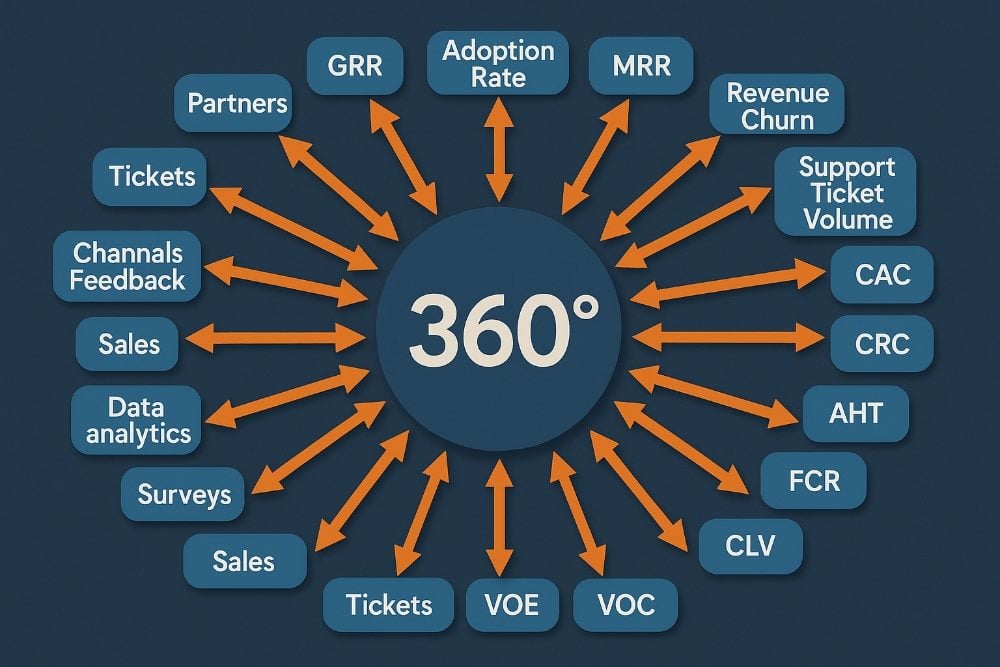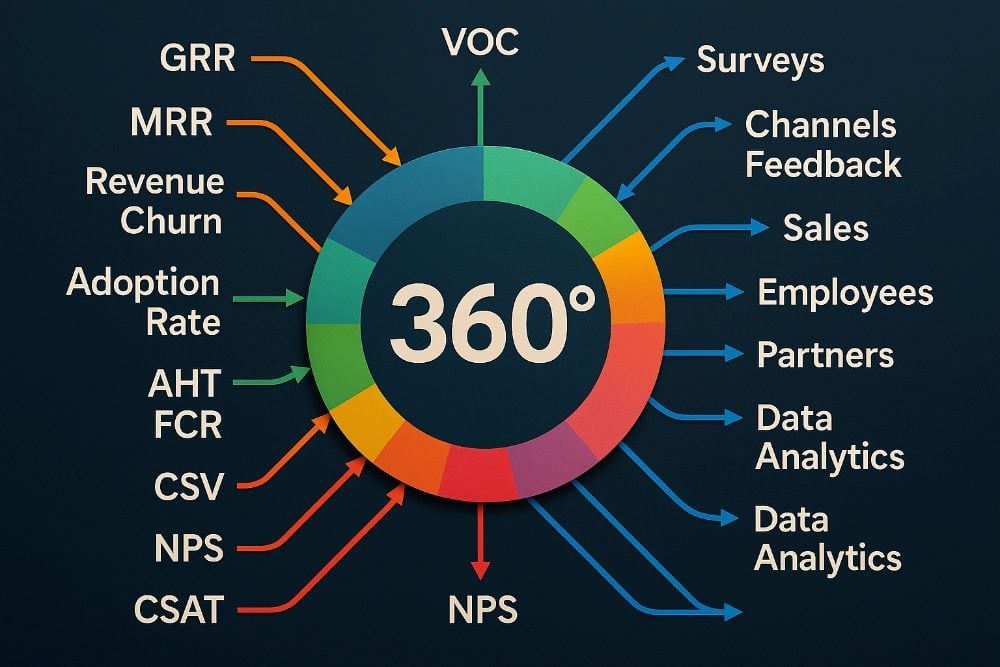The Gist
-
Integrated CX data. Technology companies are consolidating customer feedback from multiple channels into one unified platform for more accurate CX insights.
-
Holistic measurement. B2B companies are moving beyond individual satisfaction scores and measuring CX at the account level, considering all stakeholders and touchpoints.
-
Business impact focus. CX metrics are now directly linked to business outcomes, such as revenue, retention and operational efficiency. This helps make sure CX efforts drive real value.
Editor’s Note: This article is Part 2 of CMSWire’s two-part series on the transformation of customer experience (CX) metrics in technology enterprises. In Part 1, we explored how companies are evolving beyond outdated measurement methods. In this second installment, we examine how they’re connecting CX data to business outcomes, integrating customer signals across departments and using real-time insights to drive strategic decisions.
Technology companies are overhauling how they gather and unify customer feedback. The new trend is one integrated voice of the customer platform that consolidates all feedback channels and data sources. In the past, a company might have had separate silos; one team would run NPS surveys while another would monitor social media and another would track support calls. Now, firms aim to bring all these together for a single source of truth on CX.
A notable example is Fujitsu, the global tech services provider. Fujitsu decided to move beyond relying solely on NPS surveys; they built a comprehensive VoC system that aggregates input from customer interviews, support ticket data and social media comments into one repository. This meant a project manager could see everything a key client had expressed on one dashboard. By doing so, Fujitsu made sure that no signal was missed and that feedback was understood in context.
Another example is Oracle, which has a vast enterprise client base. Oracle has been integrating its various feedback streams (i.e., annual relationship surveys, event feedback, support call quality scores and community forum discussions) into one AI-driven analytics platform. The platform can, for instance, correlate a drop in product usage with an uptick in support complaints and negative comments on social media. All this together could indicate that a specific customer account is struggling. That unified view triggers Oracle’s account team to act quickly.
The broader point is that measuring CX is no longer the domain of one department with one tool; it’s an organization-wide, data-unified effort. Companies are investing in platforms that pull every VoC data point together. This break from siloed metrics means when leadership reviews customer experience, they see the full mosaic rather than isolated fragments. This is measurement through consolidation, and it allows more accurate prioritization of improvements that span the entire customer journey.
Table of Contents
- Tracking CX Metrics at Account and Stakeholder Levels
- Analyzing Customer Journey and Reducing Effort
- Linking CX Metrics to Business Outcomes
- Creating a Data-Driven, Customer-Centric Culture
- Using CX Data for Real-Time Strategic Decisions
Tracking CX Metrics at Account and Stakeholder Levels
In business-to-business tech, a major measurement change has been recognizing that the customer is a multifaceted entity (a whole company with multiple people, not one individual). Thus, CX metrics must account for all key stakeholders and touchpoints in an account, not just a single user’s opinion. Many enterprise providers have shifted from user-level satisfaction to account-level health metrics.
Account-Level Scoring: How Leading Vendors Measure CX
For example, Cisco now evaluates customer experience on an account basis. They may conduct executive-level relationship surveys for decision makers, conduct transactional CSAT surveys for end users (i.e., engineers using Cisco tools), and measure account-wide outcomes like ROI achieved. Cisco’s customer experience team combines these inputs into an account “CX scorecard” so that a large client has a unified experience assessment. This prevents the classic B2B pitfall where a single contact’s survey was taken to represent the entire Fortune 500 customer’s health.
Oracle follows a similar practice by gathering feedback from different personas within a client (i.e., end-user satisfaction, project manager feedback on implementation, and executive feedback on value and support). Oracle then aggregates these perspectives. The result is a more reliable measure of the overall customer relationship.

Another aspect of B2B CX measurement is weighting metrics by account value and context. IBM, for instance, might give more attention to a medium NPS from a strategic $10M client versus a slightly lower score from a small account. This nuance could be lost if one looks only at averages.
Additionally, B2B firms often use customer effort score after support interactions with technical users to make sure the service experience is easy for the people actually using it. Zendesk has many B2B clients that employ its support platform’s built-in metrics to gauge effort and satisfaction at the ticket level; those feed into a larger customer success view for the client company.
Why Multi-Stakeholder Metrics Matter in B2B CX
In summary, measuring enterprise customer experience now means measuring at multiple levels (i.e., each interaction’s quality, each user’s sentiment, and the account’s overall outcomes). This multi-stakeholder, hierarchical approach provides a far better indicator of account health than any single metric could. It acknowledges that in B2B, a great experience means different things to different roles, and all of them matter.
In the end, intelligent customer experience is not about the tools we deploy, the dashboards we watch, or the AI we embed — it’s about how we align strategy, culture, data, and design to create meaningful outcomes.


Analyzing Customer Journey and Reducing Effort
Another key change in CX measurement is focusing on customer journeys and the effort required at each step, rather than isolated touchpoints. Companies are realizing that a customer’s end-to-end experience (for example, onboarding a new software tool) is what matters, and it must be measured holistically.
Journey Analytics in Action: Adobe and CES
This has led to the rise of journey analytics and customer effort score (CES) as a metric at specific journey stages. For example, consider Adobe when it onboards enterprise clients to Adobe Experience Cloud. Instead of only measuring satisfaction after the entire project, Adobe monitors each phase. Was the contract setup easy? Was the integration process smooth? Was the user training effective? They use journey analytics to see where customers spend the most time or hit obstacles. If data shows that integration with third-party data sources is where many projects stall, Adobe zeroes in on that stage to improve it. They might also use a quick CES survey right after integration is complete, asking the team “How easy was it to accomplish this step?” This yields a metric on effort for that critical step.
From Support to Systemic Fixes: How Companies Use CES
CES is increasingly popular because it directly measures friction. Companies like Cisco and ServiceNow have adopted CES in their support and implementation journeys. Cisco found that for long-term loyalty in network services, reducing effort (making processes easier) was a better predictor than delighting customers with flashy features. They now ask customers to rate how easy it was to resolve their support issue, and they track that as a KPI alongside traditional satisfaction.
ServiceNow similarly tracks effort for customers implementing its workflows, under the philosophy that an effortless experience drives higher adoption. Meanwhile, tools like Adobe’s Journey Analytics or IBM’s journey mapping services help businesses attach metrics to each stage of a journey.
This journey-centric measurement is a shift from departmental metrics. It forces different parts of the organization to look at the customer’s view. Did the customer smoothly accomplish their goal across all silos? If not, where did we make them expend too much effort? By measuring at the journey level, companies identify pain points that no single touchpoint metric would reveal, and they can fix systemic issues to create a more effortless, cohesive experience.
Related Article: Customer Touchpoints: The Key to Unifying the Customer Journey
Linking CX Metrics to Business Outcomes
C-level leaders care about customer experience not just for its own sake, but for its impact on business performance. Thus, a crucial evolution in CX measurement is tying customer experience metrics directly to financial and operational outcomes. Instead of treating “CX score” as an abstract number, companies are making sure improvements in CX link to things like revenue, churn, customer lifetime value and cost.
From Satisfaction to Strategy: How Metrics Drive Business Impact
For example, HubSpot doesn’t only track customer happiness in a silo; they also track net revenue retention (NRR), the percentage of recurring revenue retained and expanded from existing customers. This is a key top-level metric of customer experience success. If HubSpot’s NRR is climbing, it signals that customers are growing with the company, which implies their experience is positive. If NRR dips, it prompts an investigation into customer feedback and issues.
Adobe similarly correlates its customer success metrics with renewal rates of its subscriptions. Adobe’s teams analyze whether accounts with higher engagement and satisfaction scores also have higher renewal and expansion rates (spoiler: they usually do). This analysis has led Adobe to develop an “Experience Index” internally which blends traditional metrics with outcome metrics.

Another example is how companies measure the ROI of CX initiatives. IBM might pilot a new AI support chatbot to speed up responses, and they will measure not just CSAT after chats but also the reduction in support costs and improvement in case resolution times. This could help tie CX improvement to operational efficiency gains.
Gartner has even proposed new metrics like the “value enhancement score,” which asks customers whether a service interaction actually added value to their usage of the product. This moves beyond asking “Were you satisfied” to “Did we help you achieve more?,” directly connecting service quality to the customer’s success.
Forward-thinking companies embrace such value-focused metrics. For instance, when Oracle supports a client’s cloud implementation, Oracle might measure the time to first value (how quickly the client went live and got benefits from the software) as a primary success metric. These approaches help make sure that CX measurement is not an ivory-tower exercise but one intimately linked with business KPIs.
Holding CX Accountable: Why Outcomes Must Follow Insights
This linkage also forces accountability. It’s not enough to see a CSAT score rise if churn isn’t improving. By aligning CX improvements with concrete outcomes like revenue growth, cost savings and customer lifetime value, tech companies make sure their measurement of experience truly reflects business value created.
Creating a Data-Driven, Customer-Centric Culture
The most strategic change is creating a culture and system where measuring customer experience is embedded in decision-making at all levels. Technology companies are broadening their approach to CX metrics by making them a shared discipline, supported by both data science and frontline intuition. This means breaking down barriers between departments so everyone looks at CX data and empowering teams with AI-driven insights they can act on daily.
Making CX Measurement a Team Sport
For example, SAP has infused its “X-data and O-data” philosophy (experience data and operational data) across the organization. Sales teams review customer sentiment trends before renewal calls; product teams get alerts from real-time user feedback analytics; executives see dashboards that tie experience indicators to quarterly revenue. The measurement is not seen as a periodic report but as live intelligence guiding decisions.
Accenture noted in a recent study that only a minority of companies currently use data-driven insights from customer service in real time; those that do are far more likely to innovate and respond quickly. Leaders who invest in training and tools make CX metrics accessible and meaningful for every team.
Live Insights, Real Action: How AI Powers a Listening Culture
ServiceNow provides its managers with AI-powered “experience insights” where, for example, a spike in customer effort on a process automatically triggers an internal review and improvement plan. This kind of responsiveness creates a continuous loop where you measure, gain insights, take action and then measure again. Moreover, companies are expanding their metrics to include factors like trust and emotional loyalty, often using advanced text analytics or in-depth interviews, to capture the softer aspects of CX that numbers alone can’t.
All of these changes point to a strong direction; CX measurement is becoming more comprehensive, real-time and strategic. Tech companies are treating CX metrics not as static reports for the dashboard, but as dynamic guidance systems for the business. They are embracing AI to gather richer insights and building a culture that values listening to the customer’s voice. This approach to metrics is more comprehensive, and it combines qualitative and quantitative data, as well as short-term and long-term factors, to effectively measure and improve what matters most to customers.
Related Article: Create a Customer-Centric Culture Through Engaged, Empowered Teams
How Leading Tech Companies Are Advancing Customer Experience Metrics
These companies are transforming how they measure and act on CX by focusing on real-time data, integrated platforms and outcome-based insights.
| Company | CX Measurement Practice | Key Takeaway for CX Leaders |
|---|---|---|
| Fujitsu | Built a comprehensive voice of the customer (VoC) platform aggregating NPS, interviews, support tickets and social media feedback. | Move beyond survey-only metrics by consolidating all customer signals into one unified system. |
| Oracle | Integrated feedback from different personas and multiple channels into a unified CX analytics platform. | Use AI-driven platforms to detect account issues early and drive cross-functional CX action. |
| Cisco | Uses an account-based CX scorecard combining surveys, CSAT, ROI and customer effort score (CES). | Measure CX at the account level to reflect the full range of B2B stakeholders and interactions. |
| IBM | Weighs CX feedback based on account value and tracks the ROI of CX initiatives like AI-powered chatbots. | Align CX investments with strategic account impact and operational efficiency. |
| Adobe | Applies journey analytics and CES to every phase of onboarding and integration for enterprise clients. | Measure and optimize each stage of the customer journey to reduce friction and improve satisfaction. |
| HubSpot | Links CX success to net revenue retention (NRR) and uses it as a primary CX performance indicator. | Tie CX performance to revenue outcomes to reinforce its strategic business value. |
| ServiceNow | Uses AI-powered “experience insights” to track CES and trigger real-time internal improvement loops. | Leverage AI to automate insight-to-action cycles and proactively reduce customer effort. |
| SAP | Implements “X-data and O-data” strategy to connect experience data to operations across departments. | Integrate customer feedback into sales, product and executive workflows for holistic CX decisions. |
| Gartner | Promotes new outcome-based metrics like the Value Enhancement Score. | Evolve from satisfaction-only metrics to value-driven questions that reflect customer success. |
| Accenture | Highlights that few companies act on customer service insights in real time — but those that do excel at innovation. | Invest in real-time insight systems to enable rapid innovation and responsiveness across the org. |
Using CX Data for Real-Time Strategic Decisions
A profound transformation is underway in how technology enterprises measure customer experience. The era of relying on a single score like net promoter score and a handful of lagging surveys is giving way to a smarter, broader approach fueled by data and AI. Industry leaders are crafting multi-dimensional scorecards that combine sentiment, effort, usage and outcome metrics for a 360-degree view. They are listening continuously through AI analytics that pick up every signal, not just the loudest voices. They are predicting future problems before they happen and tying customer experience improvements directly to retention and revenue.
Smarter Signals, Stronger Strategy: The Future of CX Measurement
Perhaps most importantly, they are breaking down the old silos, unifying customer feedback across channels and infusing those insights into all parts of the business. For C-level decision-makers, this new measurement paradigm offers a more truthful and actionable read on customer experience. It reveals not just how customers say they feel, but what they actually do. It connects the quality of experiences to the bottom line and allows smarter investment in the initiatives that drive loyalty and growth.
The direction of CX measurement is clear. It’s becoming more real-time, more predictive, more integrated and more closely tied to value. Tech companies that embrace these advanced measurement practices position themselves to detect problems early and systematically deliver the kind of customer experiences that build lasting competitive advantage. In a world where customer expectations keep rising, measuring experience in a smarter way has become essential for truly customer-centric, resilient growth.
Learn how you can join our contributor community.
